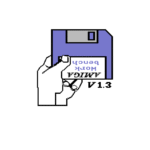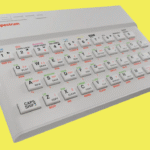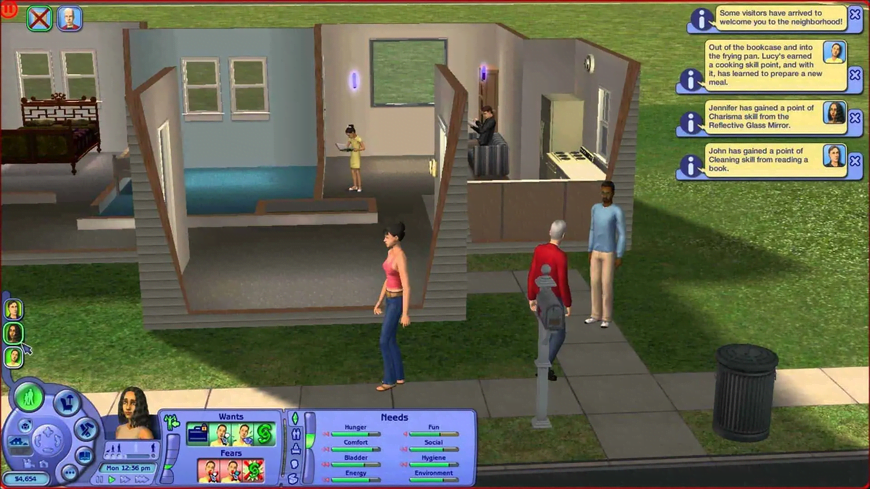It was The Sims 2 that helped Will Wright’s series of super-powered Tamagotchis to develop from cute game to mega franchise.
The Sims will not run on a budget PC World tower with a Cyrix processor and ATI graphics. That was the first thing I learned about Will Wright’s magnum opus, having spent three sheets on the CD-ROM in 2000.
After upgrading my PC (with the help of a friend, who introduced me to the world of GPUs and bus speeds), I was finally able to play The Sims, and liked it so much that I went back for more. Yes, I also bought The Sims 2 – along with some of its expansion packs.
What is the attraction of tiny computer people?
Like it’s spiritual forerunner Little Computer People, Will Wright‘s The Sims series lets you build (or ruin) the lives of Sims. Dating and matchmaking (and rumpy pumpy) is a regular dimension of gameplay, as is the inevitable outcome of such interactions. While The Sims had babies in the original game, this time around you could control a character from birth to death. These digital representations of people have loves and likes, bugbears and bad patches, and live in homes and gardens that you design.

In many ways, it is the ultimate god game; well, if God was a cross between Alan Titchmarsh and Cilla Black.
These games have a lorra, lorra surprises.
Simlish isn’t nonsense
As thrilling as it is to ruin someone’s life (they’re not real people!) the Tamogotchi like aspect of the games isn’t the main attraction for me. Perhaps it’s because they’re so cute; perhaps it’s because I studied English Language at A Level with a heavy dose of linguistics.
Perhaps Sims make sense when I’m drunk.
Whatever the reason, I just adore Simlish. The Sims 2 has over 50,000 lines of dialogue, all of which is utter nonsense to the untrained ear. Simlish has inspired multiple dictionaries; it has a huge Wikipedia page almost as long as the entry for the first Sims game!
First developed for SimCopter (a title I’m yet to play, although I am familiar with Wright’s earlier Raid on Bungeling Bay), Simlish has since popped up in a number of different games, including Sid Meier’s SimGolf and Spore.
Expanding into real estate
As with The Sims before it, The Sims 2 offered a number of expansion packs, enabling you to take your Sims to new places. As enticing as these were (and I picked up a couple), I was more interested in the economy that sprung up around the games.

Items for The Sims (some of which can still be accessed) could be downloaded and added to the game. This early example of a modding community covered everything from custom wallpaper and house designs to character skins. Some were free, but others came with a price. People were actually making money from The Sims, and they weren’t working at EA!
The Sims 2: my favourite Sims
The thing about The Sims 2 is that it didn’t break the original, it just improved upon it. Conversely, The Sims 3 and 4 have taken what seems to me to be a somewhat odd turn into trying to be everything to everyone.
And as anyone knows, if you try to be all things to everyone, you end up being nothing to no one.
I don’t know anyone who plays The Sims games in 2024. Perhaps the game was merely of its time; but then, Tamagotchis came back, didn’t they? That really indicates to me that the overcomplicated worlds and interactions of The Sims 3 and 4 lack the charm and magic of the first two games.
The Sims and The Sims 2 were fun, didn’t rely on divisive social dimensions, and gave you something positive to aspire to.
Sul sul!
Affiliate Disclosure: Some of the links in this post may be affiliate links, which means I may earn a small commission if you make a purchase through those links. This comes at no extra cost to you. Thank you for your support!
Christian Cawley is the founder and editor of GamingRetro.co.uk, a website dedicated to classic and retro gaming. With over 20 years of experience writing for technology and gaming publications, he brings considerable expertise and a lifelong passion for interactive entertainment, particularly games from the 8-bit and 16-bit eras.
Christian has written for leading outlets including TechRadar, Computer Weekly, Linux Format, and MakeUseOf, where he also served as Deputy Editor.
When he’s not exploring vintage consoles or retro PCs, Christian enjoys building with LEGO, playing cigar box guitar, and experimenting in the kitchen.









